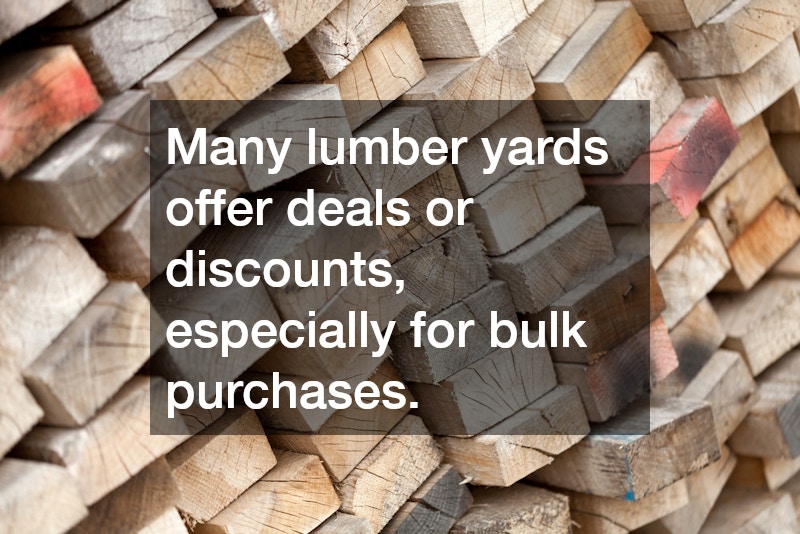
Visiting a lumber yard can be an invaluable experience for both professionals and DIY enthusiasts alike. Whether you’re embarking on a new project or simply browsing for inspiration, understanding how to navigate a lumber yard efficiently can save you time, money, and even improve your project quality. This article will answer some frequently asked questions and provide useful tips to make your visit to lumber yards a seamless experience.
What Should I Look for When Buying Lumber?
Lumber Quality and Types
Understanding the different grades of lumber and knowing how to assess the quality is crucial. Lumber is often categorized into softwoods and hardwoods, each serving different purposes depending on your needs.
Consider checking for defects such as warping, cracks, or knot presence to ensure you pick the best pieces for your project.
Being familiar with industry standards in quality, such as those defined by agencies like the American Lumber Standard Committee, can aid in assessing your lumber options. Recognizing the specific characteristics of the wood you need, whether it’s durability or aesthetic grain patterns, will steer you toward the right selections. Lumber marked with stamps indicating its grade and moisture content provides an additional layer of assurance regarding its suitability for your project.
Frequent inspection of visually similar planks might reveal subtle differences critical to achieving high-quality results. Certain projects might require pressure-treated lumber, especially for outdoor use to resist elements. By investing time in carefully selecting your materials at the outset, you reduce the risk of facing unforeseen problems in project phases.
How to Measure and Calculate the Amount of Lumber Needed?
Methods and Tools for Accurate Measurement
Accurate measurement is the key to avoiding excess material and unnecessary costs. Become familiar with various measurement tools such as tape measures and lumber calculators that can help you determine the precise quantity needed based on your project’s specifications. Online calculators are particularly helpful in accounting for kerfs (the width of material removed when cutting) and joint types that affect material requirements.
Setting aside a few minutes to document detailed plans and exact measurements can prevent costly mistakes down the line. Prioritizing accuracy in these calculations will allow you to utilize each piece of lumber effectively, maximizing its value. Making sure you understand the fundamental calculations such as board foot measurement helps keep your planning grounded and precise.
Efficiency, in lumber use, starts with comprehensive project planning, aligning your materials precisely to design specifications. Factoring in waste, cuts, and layout design is a crucial step in your preparatory phase to ensure no surprises disrupt your workflow. Leveraging knowledge of standard lumber dimensions will also significantly simplify the buying process by matching industry-standard sizes to your unique design needs.
What Are the Best Practices for Transporting Lumber?
Loading, Securing, and Transport Tips
Once you purchase your lumber, proper transport is critical to maintaining its quality. Learn about techniques for safely loading and securing lumber to your vehicle, as well as tips for transporting different lengths and types without causing damage. Using ratchet straps or bungee cords can effectively secure your load, reducing the risk of movement during transit.
Placing softer wood types between sturdier planks can prevent superficial damage such as scratches during transport. Taking advantage of a trailer when available will usually allow for more secure transport by preventing overhang stress. Planning your route with smooth roads can also help minimize the risk of bumps causing harm to your valuable materials.
Ensuring that your vehicle or trailer is well-suited to handle the weight and dimensions of lumber is a critical preparatory step. Aligning the weight of the lumber appropriately within your vehicle supports on-road stability. By understanding legal regulations regarding load limits and transport safety, you can avoid fines while ensuring your materials arrive safely and intact.
How to Get the Best Deals at the Lumber Yard?
Discounts, Deals, and Negotiation
Many lumber yards offer deals or discounts, especially for bulk purchases. Building a good relationship with staff can also result in better advice and potential negotiation opportunities. Identifying offcuts or excess stock options can provide additional savings too.
By developing rapport and frequenting the same yard, you might secure insider tips on imminent sales or access specially reserved stocks. Timing your visits post-large construction projects could lead you to discounted options as suppliers clear surplus inventory. Keeping abreast of seasonal trends in material costs might also aid in strategically timing your purchases.
Utilizing loyalty programs or memberships at larger retailer chains can offer surprising savings advantages over time. Inquiry about payment terms when working on large projects might open up beneficial financing options. Investing a little time in exploring online reviews and price comparisons can reveal optimal choices and allow you to shop more discernibly.
Whether you are a seasoned contdiscerningly embarking on a new hobby, understanding how to efficiently navigate a lumber yard is essential. By knowing what to look for in terms of quality, being equipped with the right measurement tools, ensuring safe transportation, and capitalizing on available deals, you can make your lumber yard experience both smooth and cost-effective. Armed with these tips, you’ll be well-prepared for your next visit to the lumber yard.

